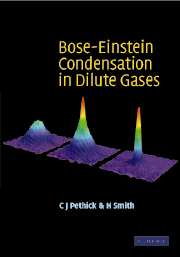Book contents
- Frontmatter
- Contents
- Preface
- 1 Introduction
- 2 The non-interacting Bose gas
- 3 Atomic properties
- 4 Trapping and cooling of atoms
- 5 Interactions between atoms
- 6 Theory of the condensed state
- 7 Dynamics of the condensate
- 8 Microscopic theory of the Bose gas
- 9 Rotating condensates
- 10 Superfluidity
- 11 Trapped clouds at non-zero temperature
- 12 Mixtures and spinor condensates
- 13 Interference and correlations
- 14 Fermions
- Appendix. Fundamental constants and conversion factors
- Index
13 - Interference and correlations
Published online by Cambridge University Press: 06 July 2010
- Frontmatter
- Contents
- Preface
- 1 Introduction
- 2 The non-interacting Bose gas
- 3 Atomic properties
- 4 Trapping and cooling of atoms
- 5 Interactions between atoms
- 6 Theory of the condensed state
- 7 Dynamics of the condensate
- 8 Microscopic theory of the Bose gas
- 9 Rotating condensates
- 10 Superfluidity
- 11 Trapped clouds at non-zero temperature
- 12 Mixtures and spinor condensates
- 13 Interference and correlations
- 14 Fermions
- Appendix. Fundamental constants and conversion factors
- Index
Summary
Bose–Einstein condensates of particles behave in many ways like coherent radiation fields, and the realization of Bose–Einstein condensation in dilute gases has opened up the experimental study of many aspects of interactions between coherent matter waves. In addition, the existence of these dilute trapped quantum gases has prompted a re-examination of a number of theoretical issues. This field is a vast one, and in this chapter we shall touch briefly on selected topics.
In Sec. 13.1 we describe the classic interference experiment, in which two clouds of atoms are allowed to expand and overlap. Rather surprisingly, an interference pattern is produced even though initially the two clouds are completely isolated. We shall analyse the reasons for this effect. The marked decrease in density fluctuations in a Bose gas when it undergoes Bose–Einstein condensation is demonstrated in Sec. 13.2. Gaseous Bose–Einstein condensates can be manipulated by lasers, and this has made possible the study of coherent matter wave optics. We describe applications of these techniques to observe solitons, Bragg scattering, and non-linear mixing of matter waves in Sec. 13.3. The atom laser and amplification of matter waves is taken up in Sec. 13.4. How to characterize Bose–Einstein condensation microscopically is the subject of Sec. 13.5, where we also consider fragmented condensates.
Interference of two condensates
One of the striking manifestations of the wave nature of Bose–Einstein condensates is the observation of an interference pattern when two condensed and initially separated clouds are allowed to overlap. An example is shown in Fig. 13.1.
- Type
- Chapter
- Information
- Bose–Einstein Condensation in Dilute Gases , pp. 338 - 360Publisher: Cambridge University PressPrint publication year: 2001



